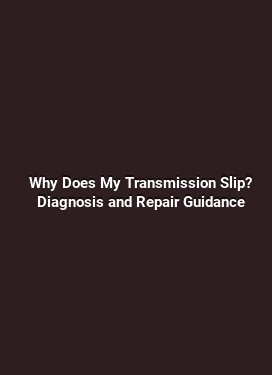How to Upgrade Clutch for 600HP Turbo Build
Rising horsepower and the inevitable stress on the drivetrain demand a well-planned clutch upgrade. For a 600HP turbo build, the standard factory clutch will often slip, fade, or fail under high torque delivery, especially during sustained launches, drag strip passes, or aggressive street driving. The goal of this guide is to provide a practical, step-by-step path to selecting the right clutch setup, understanding the trade-offs, and implementing improvements that improve reliability without sacrificing daily driving manners.
Assessing the Current Drivetrain Condition and Torque Target

Before choosing a new clutch system, perform a thorough assessment of the transmission, flywheel, and supporting components. A high-HP setup is as much about harmonizing parts as it is about raw torque capacity. Inspect the input shaft play, release bearing condition, and bellhousing alignment. The torque curve of a turbocharged engine is typically broad, with high peak torque and strong mid-range delivery. Matching the clutch to this curve requires understanding both peak torque capacity and sustained heat dissipation characteristics.
When targeting 600HP, you’ll want to quantify both peak torque and horsepower goals. For a turbo build, torque can exceed 500–600 ft-lbs at the wheels depending on gear ratio and tire choice. This translates into clutch torque capacity requirements well above the stock rating. A practical approach is to select a clutch rated for at least 1.5x to 2x the estimated peak wheel torque to provide a margin for heat and abuse. Remember that quoted ratings are often under ideal lab conditions; real-world usage, such as aggressive launches or repeated passes, will demand more robust cooling and friction material performance.
Factor in the flywheel condition and friction material geometry

The flywheel plays a critical role in clutch engagement. A lighter flywheel reduces rotational inertia, allowing quicker engagement and rev matching, but it can also increase peak clutch shock. Conversely, a heavier flywheel smooths engagement but raises inertia and response time. For high-HP turbo builds, a billet or performance flywheel paired with a specialized friction material can help manage heat and maintain consistent bite. Evaluate friction material type (organic, sintered, ceramic) in the context of daily driving versus track use. Ceramic compounds may offer high heat resistance but can be harsher on engagement; sintered options provide robust life with respectable daily usability when properly cooled.
Choosing the Right Clutch System for 600HP
Clutch systems come in several flavors, each with distinct benefits and compromises. The choice depends on driving goals, transmission type, and the available space within the bellhousing. For a 600HP turbo build, you’ll likely consider a high-torque sprung hub clutch, a multi-plate twin-disc setup, or a high-performance dual-clutch system, depending on whether the transmission is manual or dual-clutch automated. This section breaks down these options, their practical implications, and selection criteria based on real-world driving scenarios.
When evaluating clutch kits, focus on torque capacity, clamping force range, pedal effort, and engagement feel. A higher clamp load improves torque capacity but demands more pedal effort or hydraulic assist. For performance-driven street and occasional drag use, a balanced solution often lies in a twin-disc or high-torque single-disc setup paired with a reinforced pressure plate. This combination can maintain smooth engagement under load while delivering the reliability needed for aggressive launches and sustained high-HP operation.
Single-disc high-torque clutches
Single-disc clutches with reinforced pressure plates are a common upgrade path for boosted engines. They offer straightforward installation, relatively compact footprint, and a significant increase in torque capacity compared to stock units. When selecting a single-disc kit, verify the pressure plate geometry, spline count compatibility with the input shaft, and the availability of a corresponding flywheel. Enhanced clamping force can reduce slip under high torque, but it may increase pedal effort and generate more heat during prolonged clutch use. A properly tuned hydraulic or clutch master cylinder helps manage pedal feel and engagement precision. Proper bedding-in of the new friction material is essential to achieve consistent bite and reduce chatter on initial engagements.
Twin-disc and multi-plate configurations
Twin-disc or multi-plate clutch systems are designed to handle extreme torque with improved heat management. The primary advantage is staying within acceptable operating temperatures during repeated hard launches, hill climbs, or track sessions. These setups spread the load across multiple friction surfaces, reducing heat concentration and prolonging life. Installation complexity increases due to additional plates, release mechanisms, and the need for precise alignment within the bellhousing. Expect a firmer pedal and a more deliberate engagement, which is often beneficial for a race-oriented vehicle that spends little time in low-load conditions. When choosing a twin-disc kit, pay attention to hub height, spline engagement length, and the availability of a matching billet flywheel or a lightened flywheel option to optimize inertia and response.
Dual-clutch and automated transmissions
For vehicles equipped with dual-clutch transmissions (DCT) or automated manuals, upgrading the clutch is typically addressed through software calibration and clutch-pack improvements rather than a simple replacement. High-performance DCT builds require upgraded friction materials, bearing assemblies, and cooling strategies to manage the continuous torque delivery that accompanies turbocharged power. If the platform supports a hardware upgrade to a higher-capacity clutch pack, ensure compatibility with PWM-based or servo-controlled actuators. The goal is to maintain precise engagement, minimal slip under high torque, and reliable cooling during sustained use.
Upgrade Components: Beyond the Clutch
A robust clutch upgrade is more than just a new friction disc. A complete drivetrain upgrade considers the clutch mechanism in concert with the flywheel, pressure plate, release bearing, input shaft, pilot bearing, and transmission oil cooling. High-HP builds generate significantly more heat in the clutch and adjacent components. Proper cooling, lubrication, and airflow management are essential to maintain performance and avoid heat soak that leads to drag or inconsistent engagement.
Key supporting components include a billet or forged pressure plate optimized for high torque, a matching high-strength flywheel designed to minimize harmonic vibrations, and a precision throw-out bearing capable of withstanding repeated high-load cycles. Additionally, upgrading transmission oil coolers or adding an external cooler can markedly reduce heat buildup during track sessions or hard driving. Consider a clutch slave cylinder or master cylinder with improved response characteristics to deliver consistent pedal feel under high-load conditions. All these parts should be selected to maintain a reliable engagement window while preserving drivability during street use.
Input shaft strength and alignment
The input shaft is a common weak link when horsepower climbs. Upgraded shafts typically feature higher torque ratings, improved spline geometry for better engagement, and materials with superior fatigue resistance. Verify that the upgraded clutch package provides a compatible input shaft or that the transmission’s shaft can be upgraded without compromising alignment tolerances. Proper alignment minimizes premature wear and wear on the pilot bearing, ensuring smooth operation through the rpm range. Remember that incorrect alignment or imbalance can introduce vibrations that degrade shifting quality and comfort at highway speeds.
Fluid dynamics and cooling strategies
Fluids play a vital role in clutch performance. Select transmission fluid with viscosity and thermal properties suited to high torque and high heat environments. In some builds, a dedicated clutch-specific fluid or a high-temperature synthetic blend may offer improved lubrication, reduced shear, and better thermal stability. A cooler kit for the transmission or an external oil cooler dedicated to the gearbox greatly reduces heat soak, preserving clutch performance during repeated hard launches. For street use, balance cooling needs with oil viscosity to avoid excessive drag or parasitic loss while ensuring the drivetrain remains well-lubricated at low temperatures.
Installation Considerations, Alignment, and Bedding-In
Proper installation is critical to the long-term success of any high-HP clutch upgrade. The process involves meticulous alignment checks, pressure plate seating, and a careful bedding-in procedure for friction materials. Before commencing installation, ensure you have access to the correct service manuals, torque specs, and any required alignment tools. A misaligned clutch can lead to uneven engagement, vibration, or premature wear. The bedding-in process should be performed as recommended by the clutch manufacturer, typically involving gradual temperature ramp-up and controlled engagement to establish a uniform contact surface. Skipping this step can result in uneven friction engagement and reduced life expectancy.
During installation, confirm the compatibility of accessories such as pilot bearings, throw-out bearings, and release fork geometry. The interaction between the release bearing and the pressure plate must be smooth and free of binding. If the vehicle uses an hydraulic clutch system, verify that the master and slave cylinders are properly bled and that the hydraulic lines are free of air. A tuned hydraulic system maintains consistent pedal feel, which is especially important when the clutch is dealing with high torque loads in daily traffic and on track days.
bedding-in and initial drivable characteristics
The initial drivability after install is often the most telling sign of a successful upgrade. A properly bedded-in clutch will show consistent bite, minimal chatter, and a predictable engagement point. If you notice slipping during low to mid-range acceleration, recheck the friction material seating, ensure that the pressure plate is correctly aligned, and confirm that the clutch is not being overwhelmed by torque beyond its rated capacity. After bedding-in, take the vehicle on both light and moderate accelerations to verify how the clutch behaves under different load conditions. A smooth transition from idle to engaged delivers better control during launch and reduces drivetrain shock that can ripple through the transmission.
Testing and Tuning for Real-World Conditions
Testing a high-horsepower clutch upgrade involves controlled, repeatable assessments. Start with a controlled brake-stand or launch technique on a closed course to characterize engagement behavior and slip tendency. Record data such as RPM at engagement, clutch slip duration, and engine torque delivery at the moment of engagement. In daily driving, monitor pedal effort and engagement smoothness to ensure the upgrade remains practical for street use. If you notice a dramatic change in throttle response or unusual noises, inspect the bellhousing alignment, torque converter compatibility (if applicable), and any signs of heat-related clutch material glazing.
Telemetry and odometer data can help you plan maintenance intervals for the upgraded system. Track temperatures from infrared thermography or contact thermocouples on the clutch housing to identify heat hotspots. A well-balanced system prevents thermal degradation and ensures consistent performance across multiple sessions. Regular inspection of the release bearing, pressure plate fingers, and flywheel surface helps anticipate wear-related issues before they lead to failure. The ability to anticipate wear is a hallmark of a durable, performance-oriented setup that you can rely on for daily driving and sport usage alike.
Maintenance, Longevity, and Roadmap for Future Upgrades
With a 600HP turbo build, ongoing maintenance becomes a critical part of drivetrain reliability. Schedule periodic inspections of the clutch pack thickness, friction surface condition, and release interface. Proper maintenance reduces the risk of clutch slip and unexpected failure while extending the life of the entire drivetrain. If track use is part of the plan, consider more frequent fluid changes, clutch temperature monitoring, and upgrades to cooling systems to sustain performance without compromising daily usability. As the engine and turbo system evolve, you may revisit the clutch choice to accommodate higher torque targets or to optimize drivability for a broader range of road conditions.
It is equally important to ensure that the transmission and differential are robust enough to handle the increased torque. Upgrades to the gear set, upgraded cross shafts, and reinforced bearings can help preserve drivetrain integrity. A well-matched differential, particularly one with limited-slip behavior, ensures that torque is effectively distributed to the driven wheels, reducing wheel spin and improving traction during hard launches. Thoughtful integration of these components results in a cohesive drivetrain that can handle the demands of a high-HP turbo build while remaining reliable for daily use and spirited performance driving.






